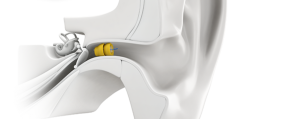UNDERSTANDING THE DIFFERENT TYPES OF DEAFNESS

05 December 2019
Because treating deafness depends on the location, the type of lesion, and the dysfunction of the hearing device, it’s important to know and understand the different types of deafness, as well as their severity.
Conductive deafness
Conductive deafness concerns a deficiency or impairment of the auditory canal, the eardrum, or the ossicular chain in the middle or outer ear. It can occur if the passage of sound waves from the outer ear to the inner ear is obstructed, and it may be caused by an earwax blockage or, especially, an infectious disorder. The most common causes of conductive deafness are otitis (including both one-time ear infections and chronic otitis media), as well as otosclerosis and a perforated eardrum. This type of deafness can be identified by difficulty understanding others’ words and by a tendency to whisper induced by an impression of speaking loudly, or by great difficulty hearing low sounds. In the case of this type of deafness, we’re talking about hearing loss that may be between 20 and 60 decibels. Conductive deafness is a type of mechanical deafness that can easily be corrected by wearing a hearing aid or by surgery.
Perceptive deafness
More common and more significant in terms of hearing loss than conductive deafness, perceptive deafness refers to all forms of hearing loss that affect the inner ear or the nerve pathways located behind the cochlea. In effect, perceptive deafness is caused by a lesion on the cochlea or the auditory nerve, and the placement of this lesion determines its name: either cochlear deafness or retrocochlear deafness. This type of deafness, which occurs at the level of the nervous transmission of sounds, affects the sensory part of hearing. Messages are poorly analyzed by the ear, either at the level of the inner ear, the auditory nerve, or the cerebral cortex, which in all cases means that information is not transmitted properly to the brain. Presbycusis, acoustic trauma, a head injury, natural aging, an infection, or sudden, hereditary, or congenital deafness can cause this type of deafness. Perceptive deafness can be identified by a difficulty understanding others’ words and, more generally, high frequencies, by a tendency to speak loudly, or by the presence of frequent tinnitus. Unfortunately, this condition is often irreversible, can affect one or both ears, and can be gradual or sudden. However, deafness can be corrected by wearing suitable hearing aids.
Mixed deafness
Mixed deafness brings together conductive and perceptive deafness, meaning that it combines poor transmission from the outer or middle ear with a perception problem in the inner ear or the auditory nerve. In general, an ear infection is the most likely cause of mixed deafness, since it can destroy the eardrum and the ossicles while at the same time altering the liquids in the inner ear. In this case too, a hearing aid is the best solution to address the hearing problems associated with mixed deafness, but it’s also possible to treat the symptoms with medication or to resort to surgery, depending on the case.
If you show signs of one of these types of deafness, make an appointment immediately with a hearing specialist such as an audiologist or an ear, nose, and throat specialist, who will show you the different kinds of treatment that are suitable for your problem.
Autres articles
RECEIVER IN THE EAR: WHAT ARE THE TECHNOLOGICAL ADVANCES ?
Why is it important to correct hearing impairments? The danger of hearing loss It’s a health problem that’s far too…
THE IMPORTANCE OF A BINAURAL HEARING AID
Many people who are hard of hearing only wear a single hearing aid. However, more than three quarters of the…
UNLOCKING THE SECRETS OF “THE HUM”: A MEDICAL PERSPECTIVE
The mysterious phenomenon known as “the Hum” has puzzled scientists, doctors, and the general populace for decades. This persistent, low-frequency…


